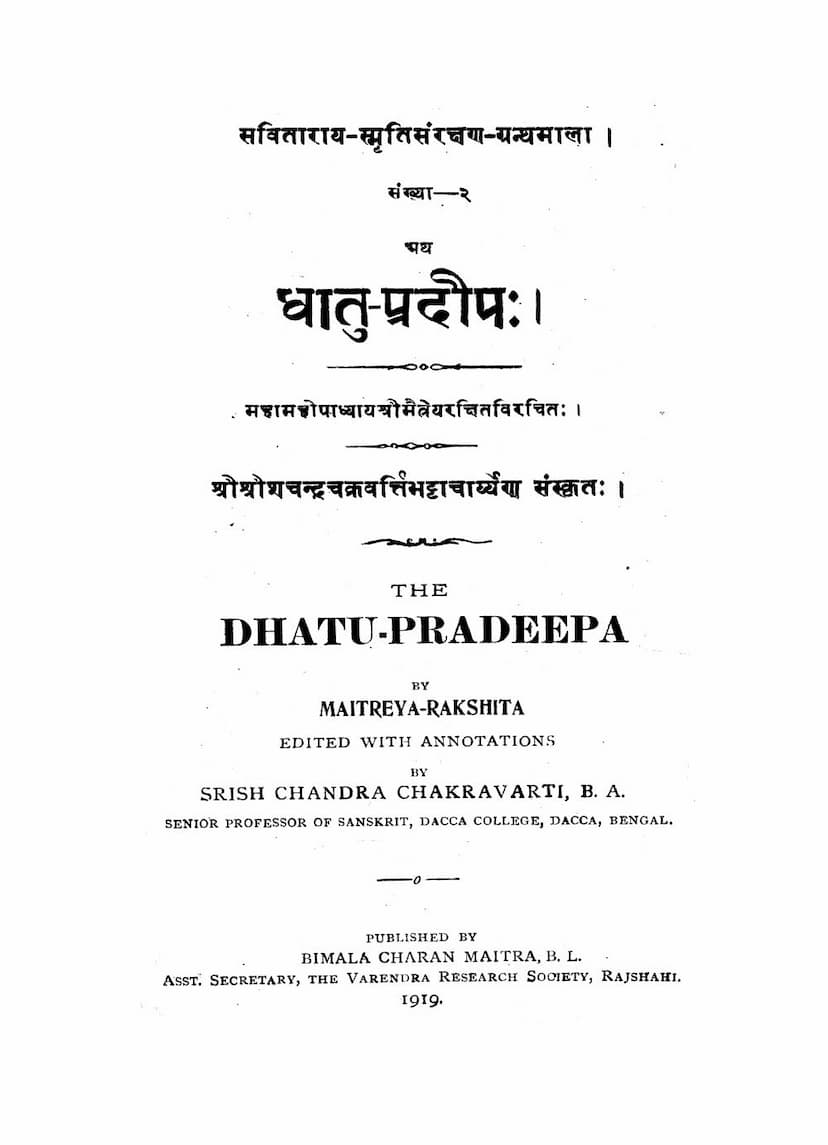Dhatupradip
Added to library: September 1, 2025

Summary
Here's a comprehensive summary of the Dhatupradip by Maitreya Rakshita, based on the provided text:
Book Title: Dhatupradip Author: Maitreya Rakshita Editor/Annotator: Srishchandra Chakravarti Publisher: Varendra Research Society Year of Publication: 1919
Overall Purpose: The Dhatupradip is a commentary on Pāṇini's Dhatu Patha, the catalog of Sanskrit verb roots. It aims to explain the meanings and grammatical behavior of these roots, providing detailed analysis and clarification.
Key Aspects and Content:
-
Commentary on Pāṇini's Dhatu Patha: The core of the Dhatupradip is its exposition of the verb roots listed in Pāṇini's foundational text. Maitreya Rakshita elaborates on each root, discussing its potential meanings and grammatical applications.
-
Extensive Citations and Influences: The text demonstrates a deep engagement with earlier grammatical and literary works. Maitreya Rakshita explicitly refers to or is quoted in:
- Grammatical Works: Bhasya, Dhatu-parayana, Amarasinha (likely Amarakosha), Kashika Vritti (by Vamana and Jayaditya), Nyasa (by Jinendra Buddhi), Katantra, Rupavatara, Upadhyaya Sarvasva.
- Literary Works: Mahabharata, Chanakya Sloka, Kalidasa, Bharavi, Bhatti, Magha, and potentially works like Ghoshakavya (likely Buddha Charita by Ashvaghosha) and Kamsavadha, Venisanhara, Maltimadhava, Kichakavadha.
- Other Works: A work called Varaha Nakshatra Purusha Prakasha.
- Later Scholars: Maitreya himself is quoted by Bhattoji Dikshita, Mallinatha, Sayana, Shripa Datta, and Sharanadeva.
-
Dating of Maitreya Rakshita: Based on his references to Kaiyaṭa (author of Bhasya and a commentator on Patañjali's Mahabhashya) and Dharma Kīrti, and his being quoted by Sharanadeva (author of Durgata Vritti, composed in 1172 AD), Maitreya Rakshita is estimated to have lived around 1100 AD. This places him in a significant period of Sanskrit grammatical scholarship.
-
The Patron "Manjughosha": The Dhatupradip begins with the invocation "Manjughosha prasādēna dhātūnāṁ vr̥ttimārabhē" (By the grace of Manjughosha, I begin the commentary on the roots). The identity of "Manjughosha" is discussed extensively in the introduction:
- Possible Interpretations: Initially considered a royal patron, ruler, or even a deity worshipped by Maitreya.
- Buddhist Connection: Strong evidence suggests Manjughosha refers to Mañjuśrī, a prominent Bodhisattva in Mahayana Buddhism, often depicted as a deity and missionary, particularly in Nepal. His worship is described in Tantric texts, and works like Sadhanamala Tantra and Paramarthasangrahi contain prayers to him. Krishnananda Bhattacharya (Agama Vagish) in his Tantra Sara also references Manjughosha.
- Grammatical Context: While Jain scholars consulted by the editor doubted Manjughosha's presence in the Jain hierarchy, the context points to either a Buddhist or Tantric influence on Maitreya Rakshita, or at least his acknowledgement of these traditions.
-
Editorial and Scholarly Context:
- Editor's Contribution: Srishchandra Chakravarti's role involved editing the text with annotations, making it accessible for study. The introduction discusses the six manuscripts used for the press copy, highlighting their variations and origins (Bengali characters, Devanagari, originating from libraries in Rajshahi, Dacca, Vizagapatam, and Madras).
- Linguistic Analysis: The text delves into detailed grammatical points, including:
- It-classification (the indication of certain sounds as "it").
- The concept of upadesha (initial pronunciation).
- The status of anusvara (nasalization).
- The nature of roots (e.g., meaning-based versus form-based categorization).
- The use of grammatical terms like luk (elision), gama (augmentation), upasarga (prefix), pratyaya (suffix), guna (vowel gradation), vr̥ddhi (vowel augmentation), samprasarana (vowel interchange), niṣṭha (past passive participle formation), and various gana (classes of roots).
- The discussion of atmanepada (middle voice) and parasmaipada (active voice) verbs, and how their usage is determined by roots' inherent nature (anudātta, udātta, svarita) and context.
- Focus on Verb Roots: The Dhatupradip is structured around the roots themselves, likely following the order of Pāṇini's Dhatu Patha. The summary highlights various categories of roots discussed, such as those starting with vowels, consonants (kavarga, takvarga, pakvarga, etc.), and their specific grammatical properties and semantic ranges.
-
Jain Connection: The catalog link and the editorial note "JAIN EDUCATION INTERNATIONAL FOR PRIVATE AND PERSONAL USE ONLY" suggest a Jain provenance or interest in this particular edition. While the introduction discusses potential Buddhist influences on the author, the text itself, as a commentary on Pāṇini's grammar, is fundamental to Vedic (Brahmanical) linguistic tradition, which also forms a basis for the study of Sanskrit within Jainism. The text's focus is on grammar and lexicography, which are universally valued across Indian philosophical traditions.
In Essence: The Dhatupradip is a significant work in Sanskrit linguistics, offering a detailed and nuanced explanation of Pāṇini's verb roots. Its author, Maitreya Rakshita, was a learned scholar who drew upon a vast body of earlier knowledge and whose work influenced subsequent grammarians. The editor, Srishchandra Chakravarti, played a crucial role in preserving and disseminating this important text through meticulous editing and annotation. The introductory discussion on Manjughosha also provides valuable historical and cultural context, suggesting possible intersections between Brahmanical, Buddhist, and Jain intellectual traditions.